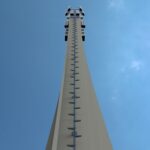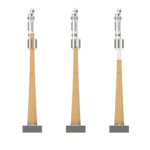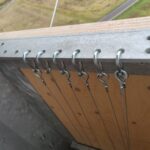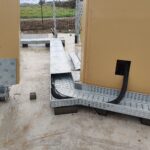Castellum - park and city area cellsites
Truck delivery includes tower parts. Delivery time is 4-12 weeks from Purchase Order and it takes 1-2 days to build the tower. Castellum has 24 months guarantee, which is expandable by using Lifecycle Services.
- 2-3 operators – high tenancy ratio
- Easier permissions for sensitive locations
- Certified low carbon footprint and CO2 sink
- Only 0,5° angle of rotation (twist)
- Up to 15 m² load of antennas
- Several tons of load in kg
- Lifetime is +30 years
- Any color, engravings or advertising signs
- Headframe exactly as you want
Castellum is a freestanding ground-based tower (GBT) with heights between 10-24 meters. It is a hybrid structure made of Laminated Veneer Lumber (LVL), Glue Laminated (GL) wood or both with a pinch of steel. The footprint at the bottom is approximately 2,5 meters. The foundation anchor is based on anchor bolts which are in concrete forming a pattern that matches to anchor blades in Castellum.
Castellum is filling or exceeding Eurocode standards and National Annexes for example in Finland and Croatia.
The charring rate is according to the standards 0,7mm/min. Biological harm prevention can be done according to national standards. The origin of the wood material is from PEFC-certified forests, wood is not impregnated. Wood elements are CE-marked.
Castellum building requires a crane and a team of 2-3 persons to install. Ecotelligent provides a Product Training Service (PTS) as a part of the pilot project per customer.
Standard truck delivery includes prefabricated tower parts. In the building phase, 1-3 elements must be lifted and connected to each other on-site.
Castellum coating is non-toxic paint or natural oil. Customers may choose any RAL color code, for example, RAL 1024.
Castellum can be equipped with customer-defined steel lattice headframe eg. square 900 x 900 or whatever dimensions are suitable for a customer. Castellum can be also fully wooden, without a steel lattice on top. In either case, vertical antenna and RRU installation tubes or frames can be installed. Tower walls can be used as wall mounting points for RRUs and cable connection boxes.
Cable holes can be on the walls of Castellum, where they are needed. Cable installation is possible inside or outside the tower. Inside cabling is shielded from weather conditions. The cable holes can be on the side of the tower, on top of the tower or at the ground level.
Castellum can be operated from outside by using 1) climbing on optional safety ladders, 2) rope access techniques and 3) manlift.
Inside access is not possible, but a hollow middle section can serve as a safe cableway, away from sight.
Castellum’s height varies from 10 up to 24 meters. Thus it is difficult to provide similar load-bearing charts as from Ecopol or Barbican, which both are more fixed structures.
As general parameters, what affects most of the static calculation of Castellum are
- Wind zone, country-specific (EN 1991-1-4/4.2)
- Antenna and fittings area, that are being installed on the Castellum as the worst-case scenario
- Terrain category (EN 1991-1-4/AnnexA)
- Earthquake areas
As an example of Castellum 24 meter customer case
- Customer headframe, antenna and RRU weigh 4135 kg
- Customer equipment wind surface 14,1 m²
- vb0 25 m/s
- Terran Category I
This type of Castellum can have a significant amount of antennas and RRUs on top and it has a good tenant ratio of 2-3 operators.
NOTE National procedures may vary country by country regarding telecom tower structures, and how they are classified by standards. Each country’s procedures must be respected and inspection and maintenance activities are followed based on local regulations.
Castellum’s inspection is carried out on a yearly basis, visual inspection every other year and a closer inspection yearly. Repainting is recommended after 10-15 years. Otherwise the structure has no special maintenance compared to ordinary steel lattice towers.
Tower inspection is a well-documented series of tasks done outside and inside of the tower, including the inspection of bolts, joints, materials, coatings, outlook, verticality, foundation and many more. Based on inspection results, possible corrective actions can be done immediately or at a different time when it is suitable for the tenants and the tower owner.



